The 64 Core Threadripper 3990X CPU Review: In The Midst Of Chaos, AMD Seeks Opportunity
by Dr. Ian Cutress & Gavin Bonshor on February 7, 2020 9:00 AM ESTAMD 3990X Against $20k Enterprise CPUs
For those looking at a server replacement CPU, AMD’s big discussion point here is that in order to get 64 cores on Intel hardware is relatively hard. The best way to get there is with a dual socket system, featuring two of its 28-core dies at a hefty $10k a piece. AMD’s argument is that users can consolidate down to a single socket, but also have better memory support, PCIe 4.0, and no cross-memory domain issues.
| AMD 3990X Enterprise Competition | |||
| AnandTech | AMD 3990X |
AMD 7702P |
Intel 2x8280 |
| SEP | $3990 | $4450 | $20018 |
| Cores/Threads | 64 / 128 | 64 / 128 | 56 / 112 |
| Base Frequency | 2900 | 2000 | 2700 |
| Turbo Frequency | 4300 | 3350 | 4000 |
| PCIe | 4.0 x64 | 4.0 x128 | 3.0 x96 |
| DDR4 Frequency | 4x 3200 | 8x 3200 | 12x 2933 |
| Max DDR4 Capacity | 512 GB | 2 TB | 3 TB |
| TDP | 280 W | 200 W | 410 W |
Unfortunately I was unable to get ahold of our Rome CPUs from Johan in time for this review, however I do have data from several dual Intel Xeon setups that I did a few months ago, including the $20k system.
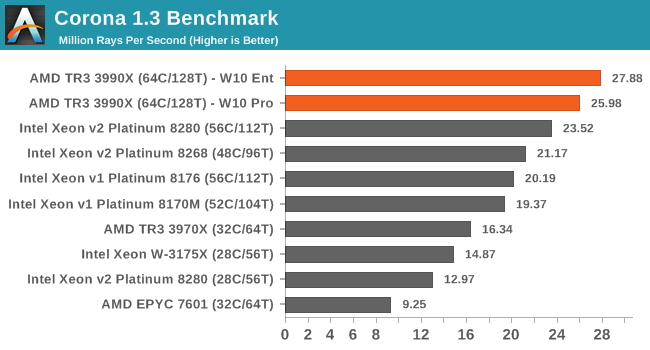
This time with Corona the competition is hot on the heels of AMD's 64-core CPUs, but even $20k of hardware can't match it.
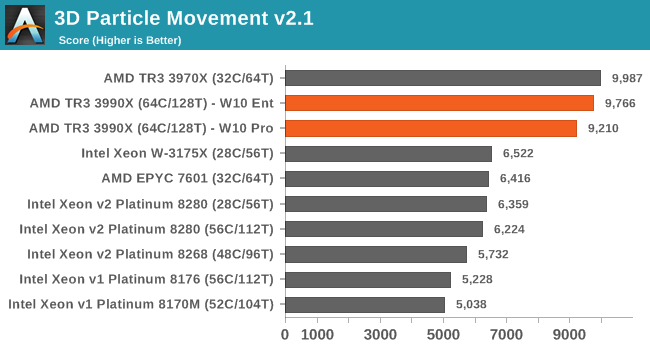
The non-AVX verson of 3DPM puts the Zen 2 hardware out front, with everything else waiting in the wings.
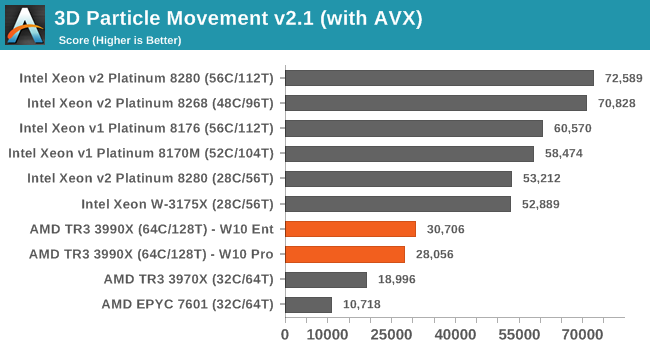
When we add in the AVX-512 hand tuned code, the situation flips: Intel's 56 cores get almost 2.5x the score of AMD, despite having fewer cores.
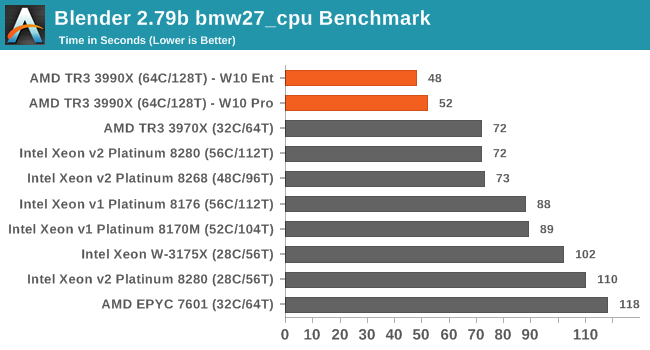
Blender doesn't seem to like the additional access latency from the 2P systems.
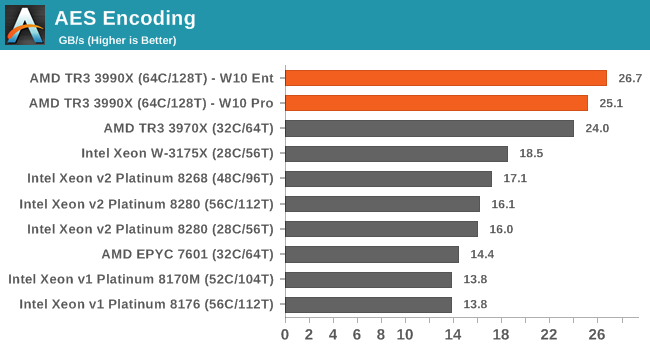
For AES encoding, as the benchmark takes places from memory, it appears that none of Intel's CPUs can match AMD here.
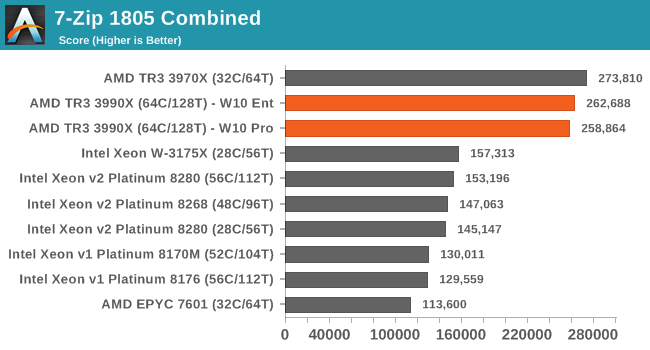
For the 7-zip combined test, there's little difference between AMD's 32-core and 64-core, but there are sizable jumps above Intel hardware.
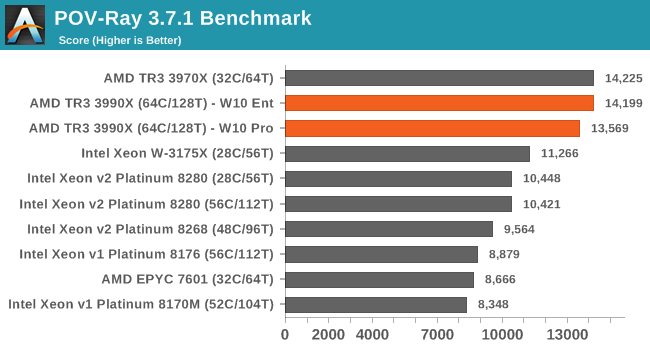

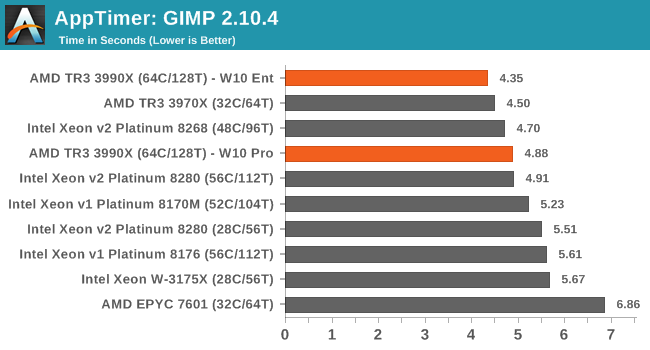
Verdict
In our tests here (more in our benchmark database), AMD's 3990X would get the crown over Intel's dual socket offerings. The only thing really keeping me back from giving it is the same reason there was hesitation on the previous page: it doesn't do enough to differentiate itself from AMD's own 32-core CPU. Where AMD does win is in that 'money is less of an issue scenario', where using a single socket 64 core CPU can help consolidate systems, save power, and save money. Intel's CPUs have a TDP of 205W each (more if you decide to use the turbo, which we did here), which totals 410W, while AMD maxed out at 280W in our tests. Technically Intel's 2P has access to more PCIe lanes, but AMD's PCIe lanes are PCIe 4.0, not PCIe 3.0, and with the right switch can power many more than Intel (if you're saving 16k, then a switch is peanuts).
We acknowledge that our tests here aren't in any way a comprehensive test of server level workloads, but for the user base that AMD is aiming for, we'd take the 64 core (or even the 32 core) in most circumstances over two Intel 28 core CPUs, and spend the extra money on memory, storage, or a couple of big fat GPUs.










279 Comments
View All Comments
velanapontinha - Friday, February 7, 2020 - link
far too many to mention in a commentandrewaggb - Friday, February 7, 2020 - link
We use both. Windows server is fine. Very long support, much longer than Ubuntu lts, and it's stable.reuthermonkey1 - Friday, February 7, 2020 - link
I'm a Linux dude through and through, but most companies I've worked for use a lot of Windows for their backend systems. I think it's a bad idea, since dealing with Windows Server adds quite a bit to overall costs and complexity, but the financial folks demand it so they pay for it.FunBunny2 - Friday, February 7, 2020 - link
"the financial folks demand it so they pay for it."because they've been slaves to Office for decades. no other reason.
Ratman6161 - Friday, February 7, 2020 - link
There is cost and then there is cost. What does that mean? Well, I'm in a highly regulated environment where if an auditor saw a system that wasn't under manufacturers support, that's an automatic fail. So lets all please get the word "free" out of our vocabulary for this discussion. Linux is definitely not free. The companies that supply Linux distros just bill you for it using a very different licensing model than Microsoft does. To find the real costs, you have to figure the total cost of a system including all hardware and software and all costs associated with each. When you do that, a couple of things become obvious. 1) The cost of hardware is relatively trivial when compared with software licensing. 2) the cost of the operating system, regardless of what that OS is, is also relatively trivial though generally speaking we find that fully supported Linux and Windows end up costing very close to the same. 3) The big costs are for the software that runs on top of the hardware and OS. So saving costs by using Linux is essentially a fantasy.RRINKER also had a great point...the vast majority of Windows servers these days are virtual. We tend to have large numbers of small Windows servers dedicated to a particular task. We don't really find this adding complexity.
Whiteknight2020 - Friday, February 7, 2020 - link
Windows server is way cheaper to administer, configuration with group policy, DSC etc is way easier than messing with ansible, puppet etc. TCO is lower as windows admins are cheaper, SA licensing is on par or cheaper than RHEL/Oracle UK, server core is rock solid. I use & deploy both Linux & Windows, whichever the application runs best or more stable on.dysonlu - Friday, February 7, 2020 - link
It's cheaper the same way it is cheaper to outsource. The cost is hidden and usually comes later.PeachNCream - Monday, February 10, 2020 - link
This is the best approach. The underlying OS should be whatever is best suited to the task it is expected to perform within the limits of the costs running it incurs. Of course, figuring out what might be the best balance between costs and performance can be tricky and a lot of companies do not dedicate the resources to examine options, simply defaulting to something familiar while assuming it is the best choice..dysonlu - Friday, February 7, 2020 - link
Enterprise use Windows because they are pretty tech-illiterate and needs Microsoft support. Nobody will get fired for selecting Microsoft and Windows, even if it'll cost more and your whole IT will be at the mercy of Microsoft.But, kickbacks help a lot in the decision making.
zmatt - Friday, February 7, 2020 - link
Many. I would argue most actually. There are certainly some areas where Linux really shines but one place where they aren't just behind but completely non existing is competing with active directory. Most offices still use AD domains, and for good reasons, and Linux doesn't have an answer to it.We have a few VM clusters that run redundant DCs. Its the only option because active directory is unique. It isn't perfect, but nobody offers a competing solution. Someone could develop an open source competitor but nobody has.